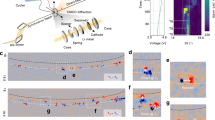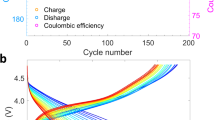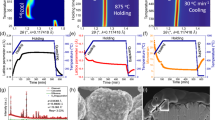Abstract
Lithium-rich layered oxides (LRLO) are among the leading candidates for the next-generation cathode material for energy storage, delivering 50% excess capacity over commercially used compounds. Despite excellent prospects, voltage fade has prevented effective use of the excess capacity, and a major challenge has been a lack of understanding of the mechanisms underpinning the voltage fade. Here, using operando three-dimensional Bragg coherent diffractive imaging, we directly observe the nucleation of a mobile dislocation network in LRLO nanoparticles. The dislocations form more readily in LRLO as compared with a classical layered oxide, suggesting a link between the defects and voltage fade. We show microscopically how the formation of partial dislocations contributes to the voltage fade. The insights allow us to design and demonstrate an effective method to recover the original high-voltage functionality. Our findings reveal that the voltage fade in LRLO is reversible and call for new paradigms for improved design of oxygen-redox active materials.
This is a preview of subscription content, access via your institution
Access options
Access Nature and 54 other Nature Portfolio journals
Get Nature+, our best-value online-access subscription
$29.99 / 30 days
cancel any time
Subscribe to this journal
Receive 12 digital issues and online access to articles
$119.00 per year
only $9.92 per issue
Buy this article
- Purchase on Springer Link
- Instant access to full article PDF
Prices may be subject to local taxes which are calculated during checkout





Similar content being viewed by others
References
Lee, J. et al. Unlocking the potential of cation-disordered oxides for rechargeable lithium batteries. Science 343, 519–522 (2014).
Sathiya, M. et al. Reversible anionic redox chemistry in high-capacity layered-oxide electrodes. Nat. Mater. 12, 827–835 (2013).
Sathiya, M. et al. Origin of voltage decay in high-capacity layered oxide electrodes. Nat. Mater. 14, 230–238 (2015).
Nitta, N., Wu, F., Lee, J. T. & Yushin, G. Li-ion battery materials: present and future. Mater. Today 18, 252–264 (2015).
Seo, D.-H. et al. The structural and chemical origin of the oxygen redox activity in layered and cation-disordered Li-excess cathode materials. Nat. Chem. 8, 692–697 (2016).
Luo, K. et al. Charge-compensation in 3d-transition-metal-oxide intercalation cathodes through the generation of localized electron holes on oxygen. Nat. Chem. 8, 684–691 (2016).
Delmas, C. Battery materials: Operating through oxygen. Nat. Chem. 8, 641–643 (2016).
Renfrew, S. E. & McCloskey, B. D. Residual lithium carbonate predominantly accounts for first cycle CO2 and CO outgassing of Li-stoichiometric and Li-rich layered transition-metal oxides. J. Am. Chem. Soc. 139, 17853–17860 (2017).
Xu, B., Fell, C. R., Chi, M. & Meng, Y. S. Identifying surface structural changes in layered Li-excess nickel manganese oxides in high voltage lithium ion batteries: A joint experimental and theoretical study. Energy Environ. Sci. 4, 2223 (2011).
Hy, S., Felix, F., Rick, J., Su, W.-N. & Hwang, B. J. Direct in situ observation of Li2O evolution on Li-rich high-capacity cathode material, Li[NixLi(1−2x)/3Mn(2−x)/3]O2 (0 ≤ x ≤ 0.5). J. Am. Chem. Soc. 136, 999–1007 (2014).
McCalla, E. et al. Visualization of O–O peroxo-like dimers in high-capacity layered oxides for Li-ion batteries. Science 350, 1516–1521 (2015).
Ye, D. et al. Understanding the origin of Li2MnO3 activation in Li-rich cathode materials for lithium-ion batteries. Adv. Funct. Mater. 25, 7488–7496 (2015).
Seymour, I. D. et al. Characterizing oxygen local environments in paramagnetic battery materials via 17O NMR and DFT calculations. J. Am. Chem. Soc. 138, 9405–9408 (2016).
Croy, J. R., Balasubramanian, M., Gallagher, K. G. & Burrell, A. K. Review of the U.S. Department of Energy’s ‘Deep Dive’ effort to understand voltage fade in Li- and Mn-rich cathodes. Acc. Chem. Res. 48, 2813–2821 (2015).
Boulineau, A., Simonin, L., Colin, J.-F., Bourbon, C. & Patoux, S. First evidence of manganese–nickel segregation and densification upon cycling in Li-rich layered oxides for lithium batteries. Nano Lett. 13, 3857–3863 (2013).
Qiu, B. et al. Gas–solid interfacial modification of oxygen activity in layered oxide cathodes for lithium-ion batteries. Nat. Commun. 7, 12108 (2016).
Liu, H. et al. Operando lithium dynamics in the Li-rich layered oxide cathode material via neutron diffraction. Adv. Energy Mater. 6, 1502143 (2016).
Chen, C.-J. et al. The origin of capacity fade in the Li2MnO3·LiMO2 (M = Li, Ni, Co, Mn) microsphere positive electrode: An operando neutron diffraction and transmission X-ray microscopy study. J. Am. Chem. Soc. 138, 8824–8833 (2016).
Wang, H., Jang, Y. I. & Huang, B. TEM study of electrochemical cycling‐induced damage and disorder in LiCoO2 cathodes for rechargeable lithium batteries. J. Electrochem. Soc. 146, 473–480 (1999).
Watanabe, S., Kinoshita, M., Hosokawa, T., Morigaki, K. & Nakura, K. Capacity fade of LiAlyNi1−x−yCoxO2 cathode for lithium-ion batteries during accelerated calendar and cycle life tests (surface analysis of LiAlyNi1−x−yCoxO2 cathode after cycle tests in restricted depth of discharge ranges). J. Power Sources 258, 210–217 (2014).
Gent, W. E. et al. Persistent state-of-charge heterogeneity in relaxed, partially charged Li1−xNi1/3Co1/3Mn 1/3O2 secondary particles. Adv. Mater. 28, 6631–6638 (2016).
Gabrisch, H., Yazami, R. & Fultz, B. The character of dislocations in LiCoO. Electrochem. Solid-State Lett. 5, A111 (2002).
Huang, J. Y. et al. In situ observation of the electrochemical lithiation of a single SnO2 nanowire electrode. Science 330, 1515–1520 (2010).
Ulvestad, A. et al. Topological defect dynamics in operando battery nanoparticles. Science 348, 1344–1347 (2015).
Yan, P. et al. Intragranular cracking as a critical barrier for high-voltage usage of layer-structured cathode for lithium-ion batteries. Nat. Commun. 8, 14101 (2017).
Pfeifer, M. A., Williams, G. J., Vartanyants, I. A., Harder, R. & Robinson, I. K. Three-dimensional mapping of a deformation field inside a nanocrystal. Nature 442, 63–66 (2006).
Clark, J. N. et al. Three-dimensional imaging of dislocation propagation during crystal growth and dissolution. Nat. Mater. 14, 780–784 (2015).
Takahashi, Y. et al. Bragg X-ray ptychography of a silicon crystal: Visualization of the dislocation strain field and the production of a vortex beam. Phys. Rev. B 87, 121201 (2013).
Nye, J. F. & Berry, M. V. Dislocations in wave trains. Proc. R. Soc. A 336, 165–190 (1974).
Hull, D. & Bacon, D. J. Introduction to Dislocations 5th edn. (Elsevier, Oxford, 2011).
Qi, Y., Hector, L. G., James, C. & Kim, K. J. Lithium concentration dependent elastic properties of battery electrode materials from first principles calculations. J. Electrochem. Soc. 161, F3010–F3018 (2014).
Yu, H. et al. Electrochemical kinetics of the 0.5Li2MnO3·0.5LiMn0.42Ni0.42Co0.16O2 ‘composite’ layered cathode material for lithium-ion batteries. RSC Adv. 2, 8797–8807 (2012).
Fell, C. R. et al. High pressure driven structural and electrochemical modifications in layered lithium transition metal intercalation oxides. Energy Environ. Sci. 5, 6214–6224 (2012).
Qian, D., Xu, B., Chi, M. & Meng, Y. S. Uncovering the roles of oxygen vacancies in cation migration in lithium excess layered oxides. Phys. Chem. Chem. Phys. 16, 14665–14668 (2014).
Delmas, C., Fouassier, C. & Hagenmuller, P. Structural classification and properties of the layered oxides. Physica B + C 99, 81–85 (1980).
Poirer, J.-P. Creep of Crystals (Cambridge Univ. Press, Cambridge, 2005).
Sun, L., Marrocchelli, D. & Yildiz, B. Edge dislocation slows down oxide ion diffusion in doped CeO2 by segregation of charged defects. Nat. Commun. 6, 6294 (2015).
Szot, K., Speier, W., Bihlmayer, G. & Waser, R. Switching the electrical resistance of individual dislocations in single-crystalline SrTiO3. Nat. Mater. 5, 312–320 (2006).
Waser, R., Dittmann, R., Staikov, G. & Szot, K. Redox-based resistive switching memories - Nanoionic mechanisms, prospects, and challenges. Adv. Mater. 21, 2632–2663 (2009).
Singer, A. et al. Nonequilibrium structural dynamics of nanoparticles in LiNi1/2Mn3/2O4 cathode under operando conditions. Nano Lett. 14, 5295–5300 (2014).
Elser, V. Phase retrieval by iterated projections. J. Opt. Soc. Am. A 20, 40–55 (2003).
Luke, D. R. Relaxed averaged alternating reflections for diffraction imaging. Inverse Probl. 21, 37–50 (2005).
Williamson, G. K. & Hall, W. H. X-ray line broadening from filed aluminium and wolfram. Acta Metall. 1, 22–31 (1953).
Kresse, G. & Joubert, D. From ultrasoft pseudopotentials to the projector augmented-wave method. Phys. Rev. B 59, 1758–1775 (1999).
Kresse, G. & Furthmüller, J. Efficiency of ab-initio total energy calculations for metals and semiconductors using a plane-wave basis set. Comput. Mater. Sci. 6, 15–50 (1996).
Perdew, J. P. J., Burke, K. & Ernzerhof, M. Generalized gradient approximation made simple. Phys. Rev. Lett. 77, 3865–3868 (1996).
Robertson, A. D. & Bruce, P. G. Mechanism of electrochemical activity in Li2MnO3. Chem. Mater. 15, 1984–1992 (2003).
Acknowledgements
We acknowledge K. Wiaderek for providing the potentiostat during the measurements at the Advanced Photon Source and H. Liu and K. Chapman for collecting the ex situ powder diffraction data on the NCA material. We also thank A. Van der Ven and M. Radin for discussions. The X-ray imaging was supported by the U.S. Department of Energy (DOE), Office of Science, Office of Basic Energy Sciences, under contract DE-SC0001805 (A.S., D.C., J.W., N.H. and O.G.S.). S.H., C.F., M.Z., H.L. and Y.S.M. acknowledge support on the materials synthesis, electrochemical and materials characterization from the NorthEast Center for Chemical Energy Storage (NECCES), an Energy Frontier Research Center funded by the U.S. Department of Energy, Office of Science, Basic Energy Sciences under Award no. DE-SC0012583. The sample exchanges and collaborations between UCSD and NIMTE are made possible with the support from Office of Vehicle Technology of the U.S. DOE under the Advanced Battery Materials Research (BMR) Program. This research used resources of the Advanced Photon Source, a U.S. DOE Office of Science User Facility operated for the DOE Office of Science by Argonne National Laboratory under contract no. DE-AC02-06CH11357. We thank the staff at Argonne National Laboratory and the Advanced Photon Source for their support. Parts of this research were carried out at the light source PETRA III at DESY, a member of the Helmholtz Association (HGF). The data are stored at Sector 34-ID-C of the Advanced Photon Source and at PETRA III at DESY.
Author information
Authors and Affiliations
Contributions
A.S., S.H., Y.S.M. and O.G.S. conceived the idea; A.S., S.H., D.C., C.F., A.U. and J.W. conducted the imaging experiments on LRLO nanoparticles, with assistance from E.M and R.H.; A.S. and N.H. performed the imaging experiments on NCA nanoparticles, with assistance from A.Z. and M.S.; S.H., C.F. and H.L. prepared the LRLO and NCA samples and performed the materials characterization and electrochemistry testing; A.S. analysed the imaging experiments with help from D.C. and O.G.S.; M.Z. performed the microstrain analysis with help from Y.S.M.; B.Q, Y.X. and Z.L. performed the superstructure restoration and subsequent electrochemistry testing; M.Z., T.W. and Y.S.M. performed the theoretical calculations; E.M. designed the sample environment. A.S. wrote the paper with input from all authors.
Corresponding authors
Ethics declarations
Competing interests
The authors declare no competing interests.
Additional information
Publisher’s note: Springer Nature remains neutral with regard to jurisdictional claims in published maps and institutional affiliations.
Supplementary information
Supplementary Information
Supplementary Figures 1–15 and Supplementary Table 1
Supplementary Video 1
A 3D representation of the displacement field inside the nanoparticle at 4.0 V state of charge. False colours as in Fig. 2a
Supplementary Video 2
A 3D representation of the displacement field inside the nanoparticle at 4.3 V state of charge. False colours as in Fig. 2a
Rights and permissions
About this article
Cite this article
Singer, A., Zhang, M., Hy, S. et al. Nucleation of dislocations and their dynamics in layered oxide cathode materials during battery charging. Nat Energy 3, 641–647 (2018). https://doi.org/10.1038/s41560-018-0184-2
Received:
Accepted:
Published:
Issue Date:
DOI: https://doi.org/10.1038/s41560-018-0184-2
This article is cited by
-
Efficient direct repairing of lithium- and manganese-rich cathodes by concentrated solar radiation
Nature Communications (2024)
-
Structurally robust lithium-rich layered oxides for high-energy and long-lasting cathodes
Nature Communications (2024)
-
Surface engineering of Li- and Mn-rich layered oxides for superior Li-ion battery
Tungsten (2024)
-
Interfacial engineering of the layered oxide cathode materials for sodium-ion battery
Nano Research (2024)
-
Suppressing strain propagation in ultrahigh-Ni cathodes during fast charging via epitaxial entropy-assisted coating
Nature Energy (2024)



